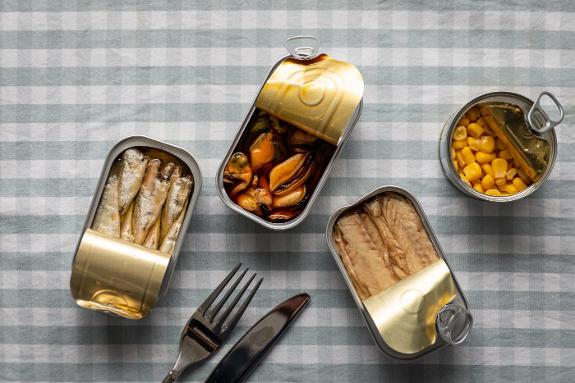Cooking with preserved foods
Kitchen cupboard tins and jars can be used to make a variety of tasty meals and save us having to make another trip to the supermarket
ESPERANZA PELÁEZ
Martes, 31 de marzo 2020, 20:14
According to the statistics, the most popular products sold in supermarkets during the last couple of weeks were dairy products, meat, fresh fruit and vegetables. However, having a few cans or jars in the larder can save us having to make another trip in a hurry.
Canning was developed to guarantee food supplies for armies in the field and ships' crews on long voyages, and also to ensure availability of out-of-season fruit and vegetables in the home.
It was Napoleon Bonaparte who, embarking on wars across Europe, offered a reward to anyone who could come up with a way to preserve food and therefore keep his troops fed.
The 10,000 Francs was awarded to Nicolás Appert, a confectioner who had developed a method of sterilising food by submerging it in liquid (fat, salt water or syrup) in glass jars sealed with wax in a bain-marie. Although Napoleon never used the method, Appert's life was changed forever; he started a new industry making preserves.
Unlike Napoleon, the British Navy quickly adopted the new system, replacing the fragile glass jars with tins. The canned food soon eradicated deaths from scurvy onboard ship as the canning process preserved the vitamins in the fruit and vegetables. It also meant that there were no longer weevils in the rations of biscuit which were also tinned, and fresh water was also taken in cans.
There has always been a certain split in types of preserved foods. There are high-priced, gourmet foods and the everyday, more affordable products. However, according to food scientist Ángel Caracuel, of the Hospital Regional Universitario de Málaga, "preserves, precisely because they have been subjected to sterilisation and the subsequent vacuum, are among the foods that contain fewer additives, and have well preserved nutrients."
So take a look at your stock of tins and jars and make the most of them with these tips and ideas for using them as ingredients in different dishes rather than as simple appetisers or salad toppings.
First though, some facts. Wet foods (meat, fish, vegetables and fresh fruit) preserved in glass jars or cans are immersed in the covering liquid, which can be the cooking liquid (light brine for vegetables, cooked beans, fresh fish or sausages for example), its own juices (canned meat), fat (fish in oil, pork loin in butter, duck confit, some sausages), acids (vegetable pickles) or the cooking sauce (preserves in tomato, ready-made dishes and, very important in the canning industry, the brines, which combine vinegar, salt and oil, three great preservatives). For fruit, syrups are used. Often, especially with vegetable or fruit, a proportion of ascorbic acid (vitamin C) is added to improve the preservation.
As a precaution, make sure that the cans are never deformed or damaged in any way and jars should make the characteristic 'pop' when you open them. Clean the can or jar before opening and, if not all the contents are used, transfer the remainder into a clean container and cover it to avoid cross contamination.
Cooking with preserves is a great option to end the boredom of always serving the contents the same way and to have ingredients with the same qualities as fresh ones at any time. However, if you are going to add vegetables, fish or tinned meat to a stew, remember that they are already cooked, so it is best to add them at the last minute. The flavour of tinned food is often attenuated or slightly altered. Correct this with seasoning and imagination.
